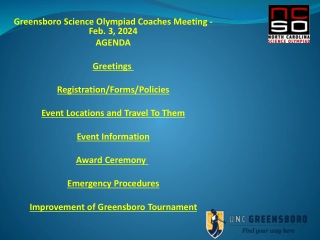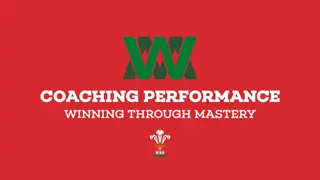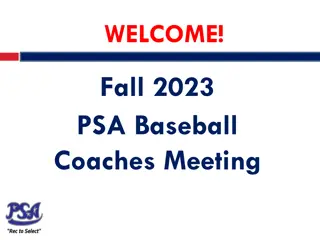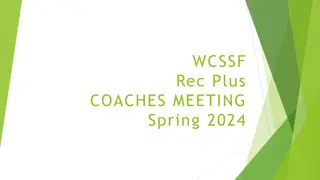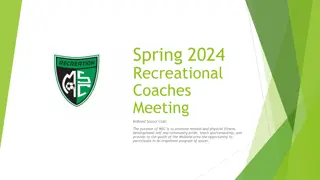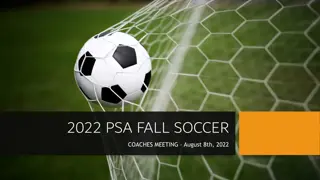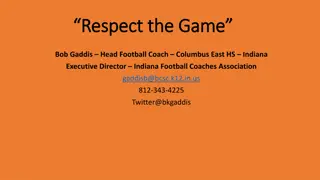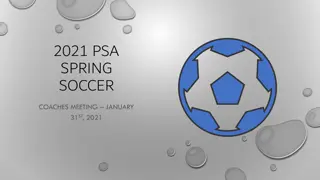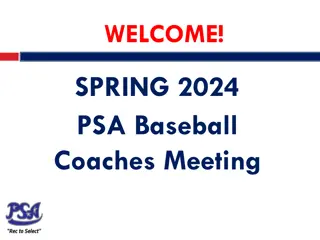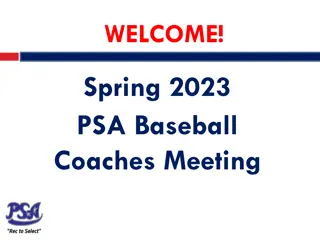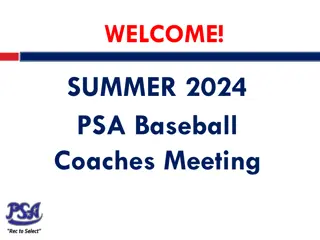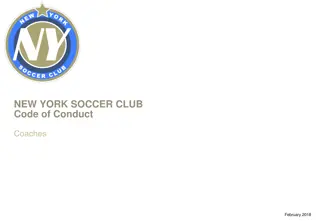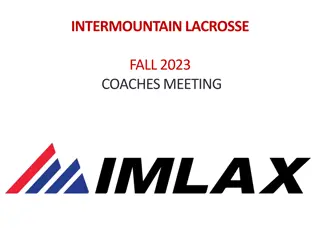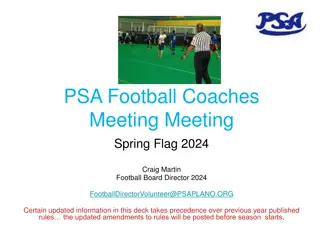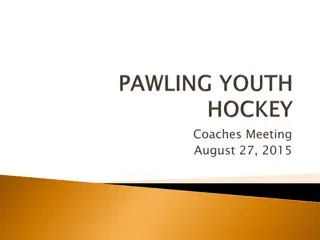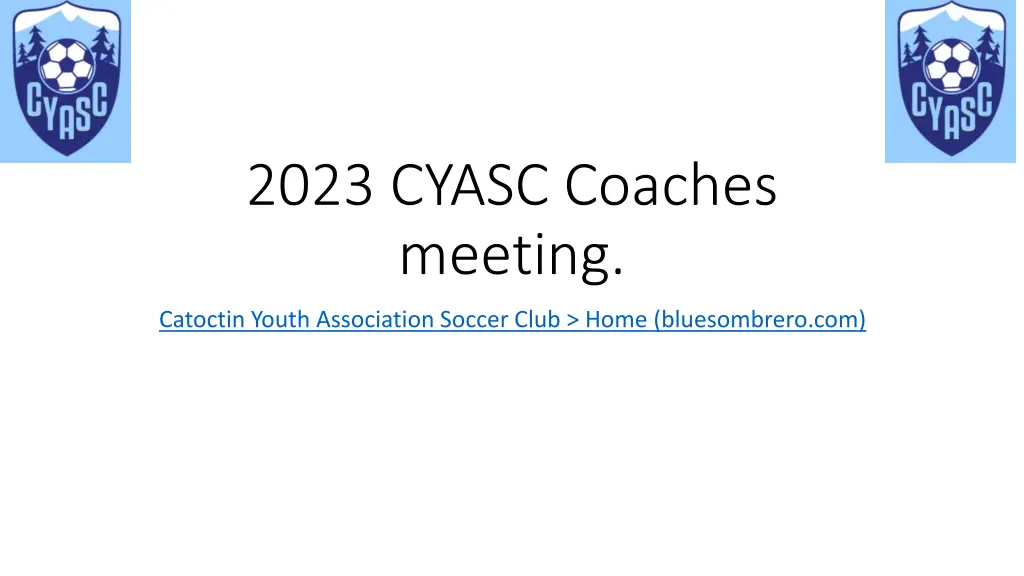
Youth Soccer Club Guidelines and Rules 2023
Stay informed about the rules and guidelines for the Catoctin Youth Association Soccer Club's 2023 season. Find information on roster sizes, game formats, field dimensions, duration of play, and more. Ensure fair play and player participation while enjoying the beautiful game of soccer.
Download Presentation

Please find below an Image/Link to download the presentation.
The content on the website is provided AS IS for your information and personal use only. It may not be sold, licensed, or shared on other websites without obtaining consent from the author. If you encounter any issues during the download, it is possible that the publisher has removed the file from their server.
You are allowed to download the files provided on this website for personal or commercial use, subject to the condition that they are used lawfully. All files are the property of their respective owners.
The content on the website is provided AS IS for your information and personal use only. It may not be sold, licensed, or shared on other websites without obtaining consent from the author.
E N D
Presentation Transcript
2023 CYASC Coaches meeting. Catoctin Youth Association Soccer Club > Home (bluesombrero.com)
Concussion Awareness Concussion Awareness Week Recognize to Recover Short Video
Games will be according to FIFA Laws of the Game with the following modifications Roster size: No maximum, however, clubs should take fairness into consideration when fielding teams and the amount of playing time that can be afforded to players on teams with very large rosters. It is the aim of the league that all players play at least half the game. Game Format: 3rd and 4th grade - 7 v 7, 6 field players and a goalkeeper. Minimum number of players on a team to start a game is 5 5th and 6th grade - 9 v 9, 8 field players and a goalkeeper Minimum number of players on a team to start a game is 6 7th and 8th grade - 11 v 11, 10 field players and a goalkeeper Minimum number of players on a team to start a game is 7 7th and 8th grade - 7 v 7, 6 field players and a goalkeeper. Minimum number of players on a team to start a game is 5 High School divisions - 7 v 7, 6 field players and a goalkeeper. Minimum number of players on a team to start a game is 5 The Ball: 3rd and 4th/5th and 6th grade - Size #4 7th and 8th grade and older - Size #5 Duration of play: 3rd and 4th grade - 2 x 25 minute half, 5 minute halftime 5th and 6th grade - 2 x 30 minute half, 5 minute halftime 7th and 8th grade - 2 x 35 minute half, 5 minute halftime High School divisions - 2 x 35 minute half, 5 minute halftime Field of play: 3rd and 4th grade - Width: minimum 30 yards, maximum 45 yards Length: minimum 45 yards, maximum 75 yards 5th and 6th grade - Width: minimum 40 yards, maximum 55 yards Length: minimum 60 yards, maximum 85 yards 7th and 8th grade 11v11 divisions - Width: minimum 50 yards, maximum 80 yards Length: minimum 100 yards, maximum 130 yards 7th and 8th grade divisions and older playing 7 v 7 See 5th and 6th grade field recommendations For all fields, the length MUST be greater than the width
Goals: 3rd and 4th grade - 6 x 18 or 6.5 x 18.5 Both goals on the field must be the same size 5th and 6th grade - 7 x 21 recommended, 6 x 18 , 6.5 x 18.5 allowed. Both goals on the field must be the same size 7th and 8th grade 11v11 divisions - 8 x 24 7th and 8th grade divisions and High School divisions playing 7 v 7 7 x 21 recommended, 8 x 24 allowed. Both goals on the field must be the same size Referee: All 7 v 7 games Center referee only, club linesmen at the referee's discretion 3rd and 4th grade and 5th and 6th grade divisions Center referee only, club linesmen at the referee's discretion 7th and 8th grade 11v11 divisions Center referee and assigned Assistant referees (2) Throw-ins: 3rd and 4th grade only! - In the event of a foul throw-in, a second attempt shall be given to the same player. A second foul throw-in and possession is awarded to the opposing team. Substitutions: Unlimited with regard to the number of players and re-entry At any stoppage of play, with the referee's permission, regardless of possession (this is actually NOT a FIFAmodification) In the event of a substitution at a penalty kick stoppage, no player entering at this stoppage may take the spot kick Unbalanced Score: This rule applies to ALL levels of play. 7v7 is used as an example and should not be construed as limiting this rule to only divisions playing 7v7 When a team is leading by 5 goals the opposing team may add a player to the field and can add an additional player for each succeeding goal up to three additional players. The additional players shall remain on the field until the goal differential is 3. At that point all additional players are removed and play resumes at 7 v 7 Unbalanced score rule clarification/example 5 goal lead - game becomes 8 v 7 6goal lead - game becomes 9 v 7 7goal lead - game becomes 10 v 7 Additional players remain on the field until the score is a 3 goal differential and the process starts over if necessary
No Heading, 3rd and 4th grade and 5th and 6th grade divisions: Whenever the ball strikes a player in the head, play is stopped. The proper restart depends upon whether the player deliberately played the ball with his or her head. If deliberate, then the proper restart is an indirect free kick to the opposing team. If this occurs within the goal area, the indirect free kick should be taken on the goal area line parallel to the goal line at the point nearest to where the infringement occurred. If the play by the head is deemed inadvertent, then the proper restart is a dropped ball. Build-out line and punting, 3rd and 4th grade division only: A line half the distance between the penalty area and the halfway line shall be established. It may be painted or marked by cones placed just outside the sideline. This line establishes where offside is called; is the line behind which the defending team must retreat when a team is awarded a goal kick or the goalie comes into possession of the ball. The defending team may advance when the ball is put back into play by the goalie to another teammate. The goalie may not punt the ball. All other methods of putting the ball into play are accepted. Club Pass players: Players from the same club may play on other teams within their club with the following conditions - They must be of the proper age group or younger than the team they are Club Passing to They may only play in two games per day They should not miss the game of the team for which they are originally rostered Club Pass players should be announced to the opposing team at a pre-game meeting of the head coaches. Teams should announce the fact they are using Club Pass Players to their opponent. Present rosters if asked. Further, if a team asks to see a roster and is refused that should be reported to the league (dshannonsoccer@gmail.com). As always, include the game number; the team asking and the team refusing. Any other information that the reporting team deems pertinent. Failure to show a roster is grounds for a forfeit review. It should be noted that the intention of the Club Pass Player rule is player centered. It is to give clubs the flexibility to have players otherwise rostered to younger or lower tier teams the chance to occasionally test their growing skills at a higher level; to ensure that teams have enough players to compete in a game rather than forfeit (i.e., let s not make any players feel they need to show up for a game when they are sick !). It is not intended to be used to stack a team with the intention of getting a certain result. Teams and clubs found to be using this rule contrary to the spirit of the rule as outlined above can be reviewed and may be sanctioned, including limiting the number of Club Pass Players allowed or having the ability to use Club Pass Players suspended. Penalties for using ineligible players can include; game forfeit, coach suspension, player suspension or more stringent sanctions based on the circumstances as determined by committee.
Player safety: Wearing of casts, braces or other medically necessary accessories. Wearing of the above items is permitted as long as they are -securely attached/worn -adequately padded and the padding is tightly secured so as not to come loose during play. -not used during the course of the game to gain an unfair advantage The acceptability of the padding will be determined by the coaches before the match. The team with the player in this situation should approach their opponent early in the warmup stage before the match for approval so if there are any necessary adjustments they can be made before the starting time of the match. The player should bring additional padding and tape or whatever is necessary to secure the padding in case the initial padding is not deemed adequate. The player/team should also be prepared to make adjustments during the match in case the padding or securing material becomes loose and/or unacceptably unsafe for further play. Using the padded device to gain an advantage - If, during the course of the game, the referee determines that the player is using the well padded device to gain an unfair advantage in the game, the referee should give a warning and if the behavior does not change the player may be removed from the game. It will be up to the referee if the player will have the opportunity to return. An example of gaining an unfair advantage would be swinging or flailing the device around in a menacing way to ward off players. While not making contact with any other player, and the possibility of injury diminished due to the padding, the player is still gaining an unfair advantage by keeping other players away in fear of injury URSL Rules Original document 04 April2021 Amended: 14 April 2021 Player Safety added 02 August 2021 Age group changes, removed all COVID references; Unbalanced Score Rule clarification; Added Fall High School divisions 12 September 2021 Clarified the Unbalanced Score Rule to ensure that it applies to all divisions of play
URSL GamedayShortcuts 3rd and 4th Grade Division Play 7v7 Goals 6x18, 7x21 with prior approval Game time 2 x 25, 5 min halftime Ball size 4 NO HEADING Re-do throw-in one time, must be the same player Buildout line is in play Unbalanced score rule (please read the full rule on the league website) Plus 5 goals add a player Plus 6 goals add another player Plus 7 add another player These additional players STAY ON until the score differential has been reduced to plus 3
URSL GamedayShortcuts 5th and 6th Grade Division Play 9v9 Goals 7x21, 6x18 with prior approval Game time 2 x 30, 5 min halftime Ball size 4 NO HEADING Unbalanced score rule (please read the full rule on the league website) Plus 5 goals add a player Plus 6 goals add another player Plus 7 add another player These additional players STAY ON until the score differential has been reduced to plus 3
URSL GamedayShortcuts 7th and 8th Grade Division, 11v11 and 7v7 Play 11v11 Goals 8x24 Game time 2 x 35, 5 min halftime Ball size 5 Unbalanced score rule (please read the full rule on the league website) Plus 5 goals add a player Plus 6 goals add another player Plus 7 add another player These additional players STAY ON until the score differential has been reduced to plus 3 Play 7v7 Goals 7x21 recommended, 8x24 allowed Game time 2 x 35, 5 min halftime Ball size 5 Unbalanced score rule (please read the full rule on the league website) Plus 5 goals add a player Plus 6 goals add another player Plus 7 add another player These additional players STAY ON until the score differential has been reduced to plus 3
URSL GamedayShortcuts High School Division 7v7 Play 7v7 Goals 7x21 recommended, 8x24 allowed Game time 2 x 35, 5 min halftime Ball size 5 Unbalanced score rule (please read the full rule on the league website) Plus 5 goals add a player Plus 6 goals add another player Plus 7 add another player These additional players STAY ON until the score differential has been reduced to plus 3
Game day requirements for Coaches. Check that all goals are safe and secure. Check field conditions. Any unsafe area report to the referee. Home games make sure you put out the corner flags. Make sure all your players have on proper safety equipment. No Jewelry. Make sure your players have water for source of hydration. Don t forget portable benches, some fields don t have benches at the field. Make sure all soccer balls are inflated. The game ball is always the home Team s ball. Should always have extra balls behind the goals. This will prevent delays chasing down balls. Make sure parents are sitting on the parents' side. There should never be a parent behind the goal. Always have soccer pennies for keeper. Home team to have pennies for jersey conflict on game day. Report all scores to the CYASC Registrar following the game. Report all yellow and red cards to CYASC Registrar and CYASC President.
Red and Yellow card Yellow card- player can play at the next game. Two yellow cards make a red. Red card- player is not allowed to play at the next game and CYASC will need to submit red card sit out notice.
17 Basic Rules of Soccer Soccer has 17 laws or rules by which the game is played. Most of these laws are easy to understand. The laws are designed to make soccer fun, safe, and fair for all participants. The object of soccer is for a player to get the ball into the other team s goal by using any part of the body except the player s hands and arms. The goalie is the only player allowed to touch the ball with the hands and arms and then only while he is located in his own penalty area. A referee is in charge of the soccer game. A referee s main objective should be the safety of the players. It is the referee s responsibility to ensure that the game remains fun for everyone. This includes players, spectators and the officials. You will undoubtedly question some of the officiating calls as you watch a soccer game. This is only natural. To be fair to the referee you should read and understand the 17 laws so that you have a good understanding of the rules of soccer. Try to keep in mind that everyone who is watching a game has a different perspective. Spectators will be most likely, rooting for one team or the other. This will influence how they view the game. The spectators will more than likely have a family member playing in youth soccer. Also keep in mind that everyone will be viewing the game from a different angle. Try to give the referee the benefit of a doubt. The referees are much closer to the play than spectators. They should be trained in the laws and impartial to the game s outcome. The 17 laws described below are the basic laws of soccer accepted throughout the world. These laws are usually altered slightly so the game is more fun and beneficial for young players. Each league should have a specific set of rules it will follow. These rules should be distributed to the coach. Look over the rules of your league to make sure you fully understand them.
LAW 1 - The Field of Play This is the basic layout of a soccer field. The size of the field will vary from league to league, usually depending on the age of the players. LAW 2 - The Ball A regulation size soccer ball is a No. 5 ball. Youth leagues may use different size balls, such as a No. 3 ball or a No. 4 ball, depending on the age of the children. LAW 3 - Number of Players There must be no more that 11 players on the field of play for either team. A minimum number of players is usually 7. Some youth leagues encourage games with less than 11 players to help in the development of young players. One player from each team must be designated as a goalkeeper. The goalkeeper must wear a different color shirt from his teammates so that everyone can easily distinguish the goalie. The goalie can only use his hands inside the penalty area. LAW 4 - Player s Equipment Players must wear the same colored jersey or shirts. All youth programs require shin guards to be worn by all players. If your players will be wearing cleats, make sure they are soccer cleats. A soccer cleat does not have a cleat at the front edge of the shoe like a baseball cleat. This is for safety.
LAW 5 - Referees The referee enforces the 17 laws. There is one difference between soccer and most other sports played in America. In soccer, the referee may let play continue and not call a foul if he or she thinks that stopping play would give an advantage to the team committing the foul. This is called the advantage clause . The referee should say play on when this occurs. LAW 6 - Linesmen and Lineswomen Two linesmen may assist the referee in controlling the game. The linesmen s duty is to signal to the referee when the ball is out; to indicate a corner kick, a goal kick or to designate which team is entitled to the throw-in. The linesmen may also signal offsides, fouls or misconduct if a goal has been scored or when substitution is desired. The referee on the field makes the official and final decisions. The linesmen are there to assist the referee; the referee may or may not act upon their advice. Coaches should not expect to have linesmen at their youth soccer games. Sometimes you are lucky to have a single referee. I have coached games where the opposing coach and I had to take turns being the referee, because an official never showed up. LAW 7 - Duration of the Game The duration of the game will depend on the age of the children. Older children will more than likely have two halves. Younger children often times play four quarters. Your league will determine whether quarters or halves are played and how long each will be. LAW 8 - Start of Play: Kick Off and Drop Ball A kick off is taken to start a game, to restart play after a goal has been scored or to start the second half or a new quarter. At kickoff all players must be on their team s half of the field. The ball is placed on the center spot in the middle of the center circle. The ball must be kicked forward at least one full rotation into the opponents half of the field. The team that kicks off to begin the game is determined by a coin toss between the captains and the referee. After a goal the team that was just scored upon starts the kick off. For new quarters and halves, the team, which did not kick off the previous quarter or half will kick off. A goal cannot be scored by kicking the ball directly into the goal on a kick off. A drop ball is played when the referee stops play for a reason other than a rule infraction. An injury is a good example. The referee restarts play by dropping the ball between two players, one from each team. A dropped ball may not be played until it touches the ground. The first player playing the ball is allowed to play the ball again without it having to be touched by another player. This means the player may dribble, pass or shoot the ball after touching it.
LAW 9 - Ball In and Out of Play The ball is out of play whenever it is completely outside the outside edge of the touchline or the goal line either on the ground or in the air. Also it is out of play when the referee stops play for any reason. The ball is in play if any part of the ball is inside or touching the touchline or goal line. The ball is considered in play after bouncing off of a goal post, cross bar, corner flag, linesmen or referee if the ball remains on the playing field. LAW 10 - Method of Scoring A goal can only be scored if the entire ball goes completely over the outside edge of the goal line, under the cross bar and between the goal posts while it is in play. Any player may score goals, including the goalie. Except when taking a free kick, throw- in, goal kick, penalty kick or kick off, a ball played by a player directly into his own goal is a score for the opposing team. LAW 11 - Offside An offensive player must have two opponents including the goalkeeper between himself and the goal line at the moment the ball is passed to him. Offside is determined when the ball is passed to the player, not when the player receives the ball. Offside position and offside are not the same. It is not against the rules to be in an offside position. It is against the rules to be offside. Here is a definition of these two concepts. Offside Position - A player is in the offside position if he is: ahead of the ball and in the opponents half of the field and there are fewer than two opponents even with or ahead of him. Offside -A player who is in the offside position becomes offside when he participates in the play or he interferes with an opponent or otherwise tries to take advantage of being in the offside position. Exceptions - A player in an offside position is not to be called offside if he receives the ball directly from: a throw-in or a corner kick or a goal kick.
LAW 12 - Fouls and Misconduct There are two kinds of fouls in soccer: Penal or Major Fouls. Non-Penal or Minor Fouls. There are nine penal or major fouls. These fouls must be committed intentionally and may result in a Red Card . The fouls are as follows: Kicking a player. Jumping up at a player. Charging a player in a rough way. Charging a player from behind. Tripping a player. Hitting or spitting at a player. Pushing a player. Holding a player. Handling the ball. (Except by a goalkeeper). This foul is called if the player is trying to control the ball with his hands or arms. If one of these nine penalty fouls is committed and the referee blows his whistle and calls a foul, the opposing team gets a direct free kick. A direct kick means the opponent can try to score a goal directly from the kick. If the player committing the major foul receives a red card from the referee, he must leave the game, and is not allowed to return. There are five non-penal or minor fouls. If a player commits a minor foul he may receive a Yellow Card from the referee. The five minor fouls are: Dangerous play. Examples of a dangerous play are: high kicking near another player s head, or trying to play a ball held by a goalie. Fair charging, but with the ball out of playing distance. Illegal obstruction. When a player intentionally takes a position between the ball and an opponent, when not within playing distance of the ball. Charging the goalkeeper in the goal area. Goalkeeper Infringements. Goalkeeper taking more than four steps while controlling the ball. Goalkeeper playing the ball with his hands when the ball is kicked by a teammate. Intentionally wasting time. (These three Goalkeeper Infringement fouls will not usually be called in young children s games.) When the referee stops play by blowing his whistle for a minor foul, the opposing team is awarded an indirect free kick. A goal cannot be scored directly from an indirect free kick. The ball must be played by a player other than the one taking the indirect kick, before a legal goal can be scored. Misconduct - There are two kinds of misconduct: When an action results in a caution or a yellow card from the referee. A referee may warn a player to improve his conduct before a caution is issued. When an action results in a player being ejected from the game, a red card . The referee has the authority to red card coaches or spectators because of misconduct or interference of the game.
LAW 13 - Free Kick There are two type of free kicks: Direct and Indirect. The types of fouls that result in a free kick are described in LAW 12. Direct Free Kick: On a direct free kick, the ball may be kicked directly into the goal for a score by the player taking the kick. The direct free kick is taken at the spot where the foul occurred, unless it is within the penalty box. Then a penalty kick is awarded. Indirect Free Kick: A goal can be scored only if the ball is touched by one or more players from either team, after it is kicked into play and before it enters the goal. There are a few rules that are followed on a free kick, they are: The referee will signal an indirect free kick by putting one arm straight up into the air. The ball must be stationary when it is kicked. The team taking a free kick is entitled to have all opponents at least 10 yards from the ball when the free kick is taken. The kicker may kick the ball if the opponents are closer than 10 yards if he wishes. The kicker may ask the referee to move the opponents back 10 yards from the ball. The kicker must then wait until the referee blows his whistle before taking the free kick. If a free kick is taken within 10 yards of the opponent s goal, opposing players may stand on their own goal line between the goal posts. A free kick by the defending team within its own goal area may be taken from any point within the half of the goal area in which the free kick was awarded. An indirect free kick by the attacking team within the defending teams goal area is taken on the six yard line at the point nearest to where the foul was committed. (The six yard line is the line that outlines the goal area). The player taking the free kick must not play the ball again after it has been kicked into play until another player, from either team, has touched the ball. LAW 14 - Penalty Kick A penalty kick is awarded when a defender commits a penal or major foul with the penalty area. The team that was fouled is given a penalty kick from the penalty mark. All players except the goalkeeper must remain outside the penalty area and penalty arc until the kick is taken. The defending goalkeeper must stand on the goal line, between the goal posts and is not allowed to move until the ball is kicked. If the goalkeeper moves and the penalty shot does not score, then the penalty kick is retaken. Encroachment is when a player enters the penalty area or penalty arc before the ball is kicked. If a defender encroaches, then a scoring shot counts, a non-scoring shot is retaken. If an attacker encroaches, a scoring shot is disallowed and the kick is retaken. If the shot was non-scoring then the defending team gets an indirect free kick or a goal kick depending on where the ball is when the referee blows his whistle. If both teams encroach, the penalty kick is retaken whether it was a scoring shot or not. The penalty kick must go forward and cannot be played again by the kicker until another player has touched the ball.
LAW 15 - Throw-in A throw-in is taken to restart a game after the ball goes out of play over the touchline. A throw- in is taken by a player from the team, which did not touch the ball last. The player throwing the ball in must have both feet on the ground and both hands on the ball over his head. Both feet must remain on or behind the touchline. The thrower must throw the ball with equal strength from both hands from the back of the head and over the top of the head. The thrower must not play the ball again until another player from either team has touched the ball. A player cannot score a goal directly from a throw-in. A player in the offside position receiving the ball directly from a throw-in is not offside. LAW 16- Goal Kick The box located directly in front of the goal is ca11e1 the goal area. When the attacking teari last touches the ball before it crosses over the goal line, the defending team is awarded a goal kick. A goal kick is taken by any player on the defending team. The ball must be played from within the half of the goal area on the side of the field where the ball went out of play. The opposing team must remain outside of the penalty area until the ball completely leaves the goal area. The goal kick is played again if the ball does not leave the penalty area, if the ball crosses the goal line before leaving the penalty area or if the ball is played again by a player from either team before it leaves the penalty area. The kicker may not play the ball again until another player from either team touches the ball. A player in the offside position receiving the ball directly from a goal kick is not offside. LAW 17- Corner Kick If a ball goes over the goal line and is last touched by the defending team, the attacking teams is awarded a corner kick. The corner kick is taken from within the corner arc on the side of the field where the ball went out of play. The corner kick may be taken by any player on the attacking team. The kicker is allowed to score a goal by kicking the ball directly into the goal. The opponents must be 10 yards back from the ball on a corner kick. The kicker is not allowed to play the ball again until a player from either team touches the ball. A player in the offside position receiving the ball directly from a corner kick is not offside.
Simple Offside Explanation and Examples - YouTube - OFFSIDE DIAGRAMS
SMALL-SIDED 3rd and 4th grade FIELDS (7 v7) OffsideLine OffsideLine
Lesson Planning click link below Lesson Plans | US Youth Soccer
PlayerDevelopment Program For the U10 SoccerCoach Section II: TechnicalTopics
Soccer Source 360s U10 Curriculum has eight technical topics that need to be introduced to all SAC players to lay a foundation for the future. These topics include: Running with the ball Front foot passing Attacking dribblingmoves Shielding Finishing Insteppassing 1st touch for groundballs As a team participating in the fall and spring season your team will practice between 20-90 times. Teams practice from 10-15 weeks each season and once, twice or three times a week. It is not enough to simply run the sessions included in this document. Map out a seasonal plan to allow for coverage of the entire u10 curriculum: improvisation, technical, tactical, and formations. Lay a strong foundation so the players will be ready for the U11curriculum. Coaches need to connect. Connect with the player Connect the technique to the game of soccer Connect the player with a passion for the game In fact, the lesson plans are sample sessions and you can modify. Changes may be needed to adjust to your team and players needs. Adjust numbers to fit with your team Adjust space to fit your player sneeds Change activities to fit your player sneeds Vary practice plan when going over topic 2nd and 3rdtime When making changes be sure to follow a simple to complex progression and have all sessions end with a game. The game is the test for the players and the coach. Have the players connected the lesson to the game. Coaches also need to recognize and capitalize on coaching/teaching moments. Know the execution of the technique. We do not recommend lecturing the players on the execution of the technique, but your knowledge base will help spot the flaws. We recommend breaking the technique down into the preparation, contact with the ball, and finishingposition. When capitalizing on a coaching moment it is recommended you vary teaching methods and not only coach flaws but use positive experiences to highlight success. TeachingMethods
Coaching the individual Most players are not disturbed and the player receives feedback for themselves. Coaching over the top Provide needed information while the activity is takingplace. Coaching at a natural stoppage Using the coaching moment when the game was stopped on its own. Ex. Ball played out ofbounds. Coaching with a stop/freeze Stopping the activity and demanding all of the players remain in the position they held when the stop command was given. This allows you to show players the picture, move players, and then rehearse the situation. Rehearsing is necessary to insure the players received the information.
U10 Running with theball What: The player takes space with the ball quickly. Where: Opportunities present themselves in all part of the field. When: Any time open space is present for the player with the ball. When a player takes the ball forward themselves, the opposition not only has to deal with the ball in a forward position but must also handle an additional player. The opponent that is forced to stop the forward progression of the ball often leaving a player or vital spaceopen. Why: How: Step 1: Recognize open space Step 2: Step through the ball with the instep of the foot. The toe should be pointed down. The touch should be large enough to take two to three steps between touches. Each touch should be made in natural running motion. Step 3: Keep the head up to see when space is closed and be aware of options. Rapid Traini ng RWB Groups of four are formedthen subdivided into groups of two. Groups of two stand 20 yards apart from eachother. One player from each group of two starts to run with the ball across the space. They attempt to take just three even length touches. When they make it to the other side the next player takes their turn and the activity continues to repeat. Ball One player starts and runs with the Cha ball across the space. Whenthe ser turnover of possession occurs the player who just had the ball chases the player who just received the ball. Each player has a turn as theplayer with the ball and the chaser.
2v2 Breakout Groups of six start with fourplayers playing 2v2 in a 10 yard by 5 yard grid. The other two players are in a similar grid 15 yardsaway. When possession changes, the player that won the ball attempts to run with the ball across to the othergroup. One defender chases this player. 2v2 continues on this side of theactivity. 4v4 game Players play 4v4 on a field that hasa designated midfield line. Each team plays 2v2 on the attacking and defensive half. The ball can only be moved into the attacking half by a player running with the ball. This player then can stay in the attacking half until the ball is lost, or a goal is scored. 4v4game It is all about connection. Canthe players connect the lesson plan into the game? Has your session had an impact on the players?
U10 Front FootPassing The player passes the ball in natural running motion with either the outside of the foot, the instep, or the top of the inside of the foot. What: Where: Opportunities present themselves in all part of the field. When: When the players are movingforward. Why: By passing the ball in natural running motion the pass is unpredictable. Step 1: As player is moving forward and has support at an angle they step through the side of the ball in natural runningmotion. How: Step 2: Continue run to support theball. Frost Tag Divide the team into two groups. One group has each player start with a ball. They attempt to hit players on the other team, who are running through the grid, below the knee with a outside of the footpass. When a player is hit they are frozen. Frozen players stand with their legs apart. They can be unfrozen by having a team mate crawl through their legs. A player can not be hit with a pass when they have any part of their body between aplayer Passand move to open cone Groups of three are formedand placed in a 5 yard by 5 yard grid with each player standing at one of the cones. Each player passes the ball withtheir front foot to one of the players and then runs to the open cone. The activity continues.
2v1ladder Groups of four are formedand subdivided. Each group is placed in an eight yard wide by 15 yard long field with a midline. Two players start on an end line and the other group places one player at the midline and one at the opposite end line from the opponent. The group of two attempts to beat the first defender by dribbling by them or making a front foot passing combination. The defender can not recover into the 2nd half box. The defender who started on the end line becomes active when the ball enters their half. 2v2 directional Groups of four are formedand subdivided into groups of two. Each group of two sets up on the end lines of a 8 yard by 15 yardfield. One team passes the ball to their opponent and begins to defend once the ball has beentouched. 4v4game It is all about connection. Canthe players connect the lesson plan into the game? Has your session had an impacton the players?
U10 AttackingMoves The player with the ball attempts to dribble past an opponent while moving the ball forward. What: Opportunities present themselves in all part of the field, but mostly in the attacking third. Where: When: When the player is moving forward with the ball and has space behind the opponent. To get by the opponent and unbalance thedefense. Why: How: Step 1: Keep control of the ball while dribbling forward. Step 2: Recognize a confronting opponent that has space behind them. Step 3: At the point the opponent is around 1 yard away, fake to take the ball in one direction. Step 4: Quickly move the ball by the opponent in the direction away from the fake. Step 5: Accelerateaway Line patters Groups of three are formedwith two players in each group starting at one cone with a ball and the remaining player starting at a cone 15 yardsaway. The first player dribbles across the space performing a pattern at the coach s command. The ball is turned over at the cone as the activity continues. Patterns Inside of foot/outside of foot Small touch/bigger touch Stop/go Chop touch/get away touch Roll/go Conedribbling variation Groups of three are formedand line up behind a group ofcones.
The players dribble around the cones with a large touch straight out then a small touch to the side of the cone followed by another large touch out to the nextcone. Each touch is perpendicular to the last touch. This dribbling move uses the small touch to get to the side of the opponent and a large touch to get by and away from the opponent. 1v1 attack/defen d 2 goal game Set up a field 25 yards long by 35 yards wide. Place two goals in the corners. Divide the group in half and have them stationed opposite a goal. Every player needs a soccerball. The activity starts with oneplayer coming out to defend against the other team. The first player on the team that did not send out the defender begins by attempting to score in one of the goals. Once a goal has been scored or they are dispossessed, the player who started with the ball becomes the defender and the first player on the opposition begins an attack. Each player takes a turn as an attacker then a defender before returning to their line.
1v1directional Groups of two are formedand placed on opposite sides of a 10 yard by 15 yard grid. Each player has aball. The player with the ball passes the ball to their partner whothen attempts to dribble the ball by the opponent and across the end line under control. 4v4game It is all about connection. Canthe players connect the lesson plan into the game? Has your session had animpact on the players?
U10 1stTouch The player gets a ground ball under control by taking a cushion or wedge touch with their foot. What: Where: Opportunities present themselves in all part of the field. When: As the player is receiving a pass, clear, or misskick. Why: To get control of the ball in order to successfully dribble, pass, orshoot. How: Step 1: Get in the path of the ball. Step 2: Decide if a cushion or wedge touch is needed. Step 3: Place foot in path of ball. Step 4: In case of cushion: withdraw foot on impact. In case of wedge: direct foot toward ball in direction of open space. Step 5: Immediate chase to be the first one to ball. Box 2box Groups of two are dividedwith each player placed in a fiveyard by five yard grid. One player plays a ball to their partner who attempts to keep the touch inside the grid. Roles reverse. Variation: The player attempts to play the first touch outside the grid but under control. Rapi Groups of two are formed and d placed in a 5 yard by 10 yardgrid. Trai One player checks to the server and receives a pass that they must control with one touch and pass back. They then run to the end line and check back to receive another pass. ning chec kto serv er
2v2sweatbox with outside neutral players Groups of six are subdividedinto groups of two. Two players start as neutral players and are placed on the narrow sides of a 7 yardby 10 yard grid. The players play possession in the grid with a two touch minimum. 2v2sweatbox Groups of four are placed in a7 yard by 7 yard grid. Twoplayers start as thedefenders. A mandatory minimum of two touch possession is use as a condition. Transition occurs naturally as the ball is won or lossed. 4v4game It is all about connection. Canthe players connect the lesson plan into the game? Has your session had an impacton the players?
U10 InstepPassing Passing the ball with the top of the foot (shoelaces). Instep passes can be short, long, driven, or lofted. What: Where: All parts of thefield. When: The player has time to plant their non kicking foot near the ball before making the pass. The most powerful way of accurately striking the ball. Why: How: Step 1: Approach the ball from anangle. Step 2: Place the non kicking foot pointing in the direction of the target either slightly behind the ball for an aerial ball or even with the ball for a pass on the ground. Step 3: In natural running motion point the toe down to offer the instep to the ball while building leg speed. Step 4: Strike through the midline center of the ball. Step 5: Continue stepping through the ball so to land on the kicking foot. Rapid Trainin g Circle Team is divided into two groups. Once group spreads out in a circle with a ball. The other group starts in the middle of the circle. Each player in the middle checks toan open ball and receives a pass and passes the ball back with the instep. They then find a new player on the outside of the circle to checkto.
Rapid Trainin g Pairs Groups of four are subdividedinto groups of two, with one group taking the role of server and the other group working on task. The players are placed around a 10 yard by 8 yardgrid. Both servers roll a pass out to one of the players. This player passes the ball back to the server with an instep pass and then checks across to the other server. The serve needs to be outside of the grid, in order for the player to be able to turn, plant the non kicking foot, and striker through the ball with the instep. 2v2+2 Three groups of two are formedand placed in a 8 yard by 10 yard grid. One group starts off as the defendingteam. The remaining four players keep possession. When the ball is lost the team responsible for losing the ball becomes the defendingteam. 4v4+2 Possession is played 4v4 with two neutral players in a 20 yard by 25 yard grid. 4v4 It is all about connection. Canthe players connect the lesson plan into the game? Has your session had an impact on the players?
U10Finishing What: Shooting to scoregoals. Where: The attacking third of the field. When: The player has an opportunity toshoot. Why: To convert scoring opportunities into goals. Rapidtraining shooting Groups of three are formedwith one player filling the role of the goal keeper. The field is set up with the goal in the middle. The two remaining players are placed on opposite sides of the goal. A player starts the activity by taking a shot. If the keeper makes the save, the ball isthen rolled to the player on the opposite side who takes a shot after receiving the ball. Make sure the players always shoot a movingball. Shots should be low, early, and on target. 2 shooting at2 Groups of four are formedand subdivided into groups oftwo. Each group of two defends agoal that is separated by 18yards. One player passes the ball to their team mate who takes a shot in an attempt to beat both goalkeepers at the opposite side. This group either makes a save and takes a shot or recovers a spare ball and takes a shot. Make sure the players alternate shooting opportunities. Have the players take a look for space in the goal before shooting
without compromisingtime. Attack/defend Divide the team inhalf andhave each team place a keeper in goal. The goals should be separated by 25 yards. Each team forms a line at one of the goalpost. One team sends a defender out and the other team s first player attempts to score a goal. When a goal is scored or the player is disposed this 1v1 stops and the team that started off defending sends a player onto the field with a ball attempting to score. The player that started off the game off attacking becomes the defender. Each player takes a turn first as the attacker and then as the defender. 2v2/3v3 revol ving game The team is divided inhalve. Each group places a player in goal and the remaining players start from either side of their defensive goal. The game starts with two players coming out for eachteam. When a goal is scored the team that was scored on leaves the field and is replaced with two new players from their team who enter with a ball. Keep score.
4v4 It is all about connection. Canthe players connect the lesson plan into the game? Has your session had animpact on the players?
U10Shielding What: The player with the ball keeps their body between the ball and opponent. Opportunities present themselves in all part of the field. Where: When: When forward progress is not probable or possible. Why: To keep possession of the ball while waiting for a passingoption. How: Step 1: Recognize forward progress in not possible or unlikely. Step 2: Move your body between the ball and the opponent in a side on position. Step 3: Bend knees to keep balance from pressure applied from opponent. Step 4: Use arm to hold player off being sure not to push the opponent. Step 5: Keep head up to see supporting players that the ball can be passed to. Knock Out Each player starts with a ball in aten yard by ten yardgrid. Players attempt to maintain possession while kicking other player s soccer balls out of thegrid. When a player has their ball dispossessed, they run after it. If the player catches the ball before itstops rolling they can come right back into the activity. If the ball stops rolling they are required to do a small penalty before re-entering the activity. Find a Ball The team is placed in a grid with2/3 of the group having possession of a soccerball. The players without a ball attempt to win a ball. On the coaches command of stop the players with a ball win and a penalty can be given to the players without a soccerball. The coach can reduce the number of soccer balls to make the activity more competitive as it progresses.
3v2 possession Groups of five are formedand subdivided into a group of two and a group of three. Players play possession and the team with possession of the ball when the coach calls stopwins. Change the players so that allplayers participate in a numbers down situation. 2v2game Groups of four are subdividedinto groups of two and play on a field 15 yards by 7 yards. Recognize when players forcepasses or turn into pressure. 4v4game It is all about connection. Canthe players connect the lesson plan into the game? Has your session had an impacton the players?
PlayerDevelopment Program For the U10 SoccerCoach Section III: Formations
U10 Formations/PositionalResponsibilities Formations are used to place players on the field by positions. Formations are simply, the allocation of players throughout the field by designating a number of defenders, midfield players, and forwards. When talking about formations, we start with the number of defenders, then midfield player, and then forwards. This means a 2-3-1 formation has 2 defenders, 3 midfield players, and 1forward. At the U10 age groups formations should be used to enhance the player development of the team members; formations should not be used to win games. Over the course of the player s progress through a long term player development plan winning will occur. At the U10 age group, players play 7 a side. We recommend choosing between a 2-3-1 and 1-3-2 formation. Both of these formations promote the principles of play through the allocation of players. Positional Responsibilities are listed below for each formation. 2-3-1 Qualities Strong defensively Allows for two defenders to work on ball side up and weak sidedeeper. Outside midfield needs to recover Provides width in attack Midfield players must support attack and find opportunities to go in advance of forward Forward must learn to make diagonal runs to coverfield Center midfield connects the two diamonds as long as the center forward makes diagonal run to ball side. Defenders PositionalResponsibilities 1v1defending Cover Ball side high, weak side deep Playing possession out of back Connecting with midfield players at supporting angles in attack
Center Midfield PositionalResponsibilities Connectingdiamonds Change point ofattack Recoverdefensively Maintainingpossession Create scoring opportunities Get in advance of forward when forward has ball and head up, and when forward has made wide runs andteam is in possession of theball 1v1 attacking and defending Outside Midfield PositionalResponsibilities Provide width in attack Crossing Recovery runs Protect weak side in defending third Maintainingpossession Get in advance of forward when forward has ball and head up in a central position, and when forward has made check runs into midfield and team is in possession of the ball 1v1 attacking and defending Forward PositionalResponsibilities Create scoringopportunities Finish scoring opportunities Make check runs toball Make diagonalruns Be first line ofdefense Maintain possession
1-3-2 Qualities Strong offensively Allows for defender to become a communicator andorganizer Outside midfield needsto recover Provides width in attack Midfield players must support attack and maintain possession. Midfield players must have commitment to defending and recovery Forward begin to learn to work with another player to unbalance the defense Center midfield connects the two diamonds as long as the defender support the ball from the ball side of thefield Defender PositionalResponsibilities 1v1defending Cover Communicate with midfield players on recovery, tracking, and marking. Playing possession out ofback Connecting with midfield players at supporting angles in attack Center Midfield PositionalResponsibilities Connectingdiamonds Change point ofattack Recoverdefensively Get in advance of forward when forward has ball and head up, and when forward has made wide runs andteam is in possession of theball 1v1 attacking and defending Provide width in attack Crossing Recovery runs Protect weak side in defending Outside Midfield
third Maintainingpossession Get in advance of forward when forward has ball and head up in a central position, and when forward has made check runs into midfield and team is in possession of the ball 1v1 attacking and defending Forwards PositionalResponsibilities Create scoringopportunities Finish scoring opportunities Make check runs to ball Make diagonalruns Be first line ofdefense Maintain possession Work with other forward to unbalance defense

